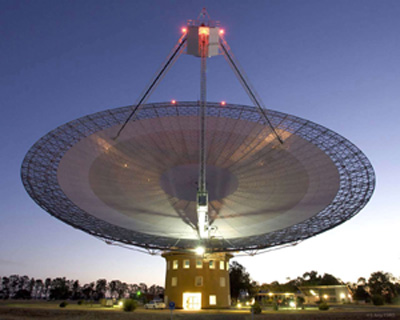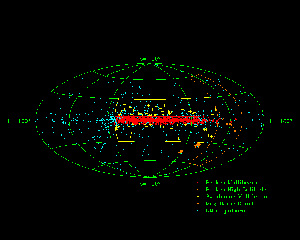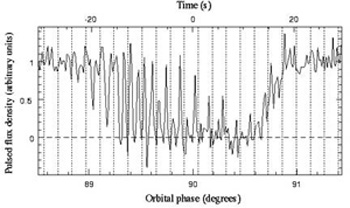Pulsar surveys and the discovery of the double pulsar
CSIRO’s Parkes radio telescope has a proud history in the discovery and investigation of pulsars – tiny spinning neutron stars formed in supernova explosions. In fact the Parkes radio telescope has found more than twice as many pulsars as the rest of the world’s telescopes put together! Most of these discoveries have been made since 1997 using the 20 cm Multibeam Receiver, a highly innovative 13-beam system which, for survey projects, effectively multiplies the area of the telescope by a factor of 13. With this system, astronomers have discovered more than 900 pulsars, almost half of the total number of pulsars known.
The ‘Jewel in the Crown’ of these surveys is the discovery in 2004 of the first-known double-pulsar system, a binary system in which two neutron stars orbiting about each other are both seen as pulsars. This unique system has proved to be an amazing laboratory for the investigation of pulsar emission physics and relativistic theories of gravity. It has given the best confirmation so far that Einstein’s general theory of relativity is an accurate description of gravitational interactions in strong-field conditions. It was voted one of the top ten discoveries of 2004 by Science magazine, one of the most prestigious scientific journals in the world.
For his contributions to pulsar research Dick Manchester was elected a Fellow of the Australian Academy of Science in 1989, was named ISI Australian Citation Laureate in 2001 and delivered the inaugural Hewish Lecture at the Cavendish Laboratory, Cambridge University, UK in 2008. He was awarded the Pawsey Medal by the Australian Academy of Science in 1979, a CSIRO Medal for Research achievement in 1993, a Centenary Medal (Australia) in 2001 and a CSIRO Medal for Lifetime Achievement in 2007.
The Parkes radio telescope and pulsars
CSIRO’s 64-m Parkes radio telescope, located near the town of Parkes in central New South Wales, about 300 km west of Sydney, is an iconic symbol of Australian science and technology. Since its inauguration in 1961 it has been at the forefront of radio astronomy world-wide, with many outstanding discoveries to its name, including the identification of the first quasar and the discovery of the ‘Magellanic Stream’, a stream of hydrogen gas linking the Large and Small Magellanic Clouds and extending half-way across the sky. These and other discoveries have been made possible by a continual program of upgrading the telescope and its receiving systems. For example, the reflecting surface has been upgraded on several occasions to allow operation at ever-increasing frequencies. In 1996, to facilitate daily tracking of the Voyager spacecraft to Jupiter, the entire focus cabin was replaced to allow rapid switching of receivers at the focal position. Another important benefit of this change was to allow the use of larger and heavier receivers such as the 20 cm Multibeam receiver. One of the areas in which the Parkes telescope has been most successful is in the discovery and investigation of pulsars (see also Parkes radio telescope construction).

Pulsar surveys
Pulsars are tiny spinning neutron stars, only about 25 km across but 1.4 times as massive as the Sun, which are formed in supernova explosions at the death of a giant star. They have extremely strong magnetic fields, about a billion times as strong as the Earth’s magnetic field, and spin at rates up to 700 times every second. The combination of this rapid spin and strong magnetic field means that pulsars are highly efficient dynamos, generating enormous electric fields in their surrounding ‘magnetosphere’. These fields accelerate charged particles to ultra-relativistic speeds and lead to the generation of intense beams of radio emission that sweep across the sky like a lighthouse beam as the star rotates. When a beam sweeps across the Earth we see a pulse. These pulses are highly periodic since it is very difficult to change the spin rate of the tiny but massive neutron stars – pulsars are incredibly good clocks! This fact leads to many important applications in diverse areas of physics and astrophysics.
Currently, about 1 900 pulsars are known and nearly two-thirds of these have been discovered using the Parkes radio telescope! This is a remarkable achievement for a telescope which, although large, is by no means the world’s largest. This success can be largely attributed to the location of the telescope in the Southern Hemisphere – the centre of our Galaxy passes almost overhead at Parkes – and to the outstanding and innovative receiver systems that have been developed by CSIRO scientists and engineers. In particular, the 13-beam Multibeam Receiver has had a major impact, not only for pulsar surveys, but also for surveys for distant galaxies using the 1.4 GHz spectral line of neutral hydrogen. With this receiver alone, more than 900 pulsars have been discovered in the period 1997-2009, nearly half the total known!

Pulsar searches exploit two basic properties of pulsars, their periodicity and the dispersion which occurs as the signals propagate through the interstellar medium. Free electrons from ionised interstellar gas result in a slight frequency dependence in the propagation velocity of pulsar signals, so that a pulse typically arrives a fraction of a second later at the lower end of a receiver frequency band than at the higher end of the band. These delays distinguish true pulsar signals from terrestrial interference, most of which is not dispersed. Signals from the receiver(s) are amplified, passed through a multi-channel filterbank and then recorded. In off-line processing, the signals from the different channels are summed with delays corresponding to a range of interstellar dispersions and then analysed using Fourier methods to search for periodic signals. Candidates from the initial processing are then re-observed to confirm (or not) that they are real pulsars. The Table below shows the main pulsar surveys that have been carried out at Parkes.
| Survey | Date | Frequency (MHz) | Nr of pulsars discovered | References |
|---|---|---|---|---|
| Early Parkes | 1973 | 750 | 8 | 1 |
| Molonglo/Parkes | 1977 | 408 | 155 | 2 |
| Parkes 20cm | 1988-1990 | 1500 | 46 | 3 |
| 70cm Southern | 1991-1997 | 436 | 101 | 4, 5 |
| 20cm Multibeam | 1997-2004 | 1374 | 781 | 6, 7, 8 |
| High-latitude Multibeam | 2000-2003 | 1374 | 18 | 9 |
| Swinburne Multibeam | 1998-2002 | 1374 | 95 | 10, 11 |
Nearly 800 pulsars have been discovered in just one survey undertaken by an international group of astronomers, the Parkes Multibeam Pulsar Survey. This survey covered a 10°-wide strip along the Galactic Equator from longitude 260° across the Galactic Centre to longitude 50°. Other companion surveys, specifically those led by a group based at Swinburne University of Technology, Melbourne and the Parkes High-Latitude Pulsar Survey, were optimised to find the older but much shorter-period ‘millisecond’ pulsars. These pulsars are believed to have been formed from old neutron stars, no longer active as pulsars, by accretion of mass and angular momentum from a binary companion. This ‘recycles’ the old pulsars, spinning them up to millisecond periods and re-activating the radio beams.
Together, these surveys have provided an excellent sample of pulsars for statistical studies of, for example, the Galactic distribution and evolution of pulsars. They have provided a sample of millisecond pulsars which are vital for projects such as the Parkes Pulsar Timing Array (PPTA) project, which aims to exploit the fantastic period stability of millisecond pulsars to make a direct detection of gravitational waves. Population studies have shown that there are more than 100 000 active pulsars in our Galaxy and that, on average, one is born every 70 years or so. The Parkes Multibeam Pulsar Survey revealed a whole new population of pulsars that have long periods (a few seconds) but are relatively young (ages of a few thousand years). They apparently have very strong magnetic fields, similar to the so-called ‘magnetars’ which primarily emit at X-ray wavelengths. However, the most exciting results from these large-scale surveys are often discoveries of unusual and sometimes unique objects which give us new insights into astronomy and astrophysics.
The Double Pulsar
There is no doubt that the ‘Jewel in the Crown’ of the Parkes pulsar surveys is the discovery of the Double Pulsar system in 2004. This amazing and so-far unique system has given astronomers a wonderful probe of relativistic gravity and pulsar emission physics. It was voted one of the top ten discoveries of 2004 by Science magazine, one of the most prestigious scientific journals in the world. The system was discovered in the Parkes High-Latitude Pulsar Survey, initially as a rapidly-spinning pulsar (pulse period about 22 ms) in an extremely tight binary orbit, with an orbital period of just 2.4 hours. These parameters implied that the mean orbital speed was about 300 km/s (0.1% of the velocity of light), which already made the system quite remarkable. It was clear that the companion star was another neutron star (most binary pulsars have much lighter white dwarf companions) but it was not until a few months later that it was realised that this companion star was also detectable as a pulsar! This made the system unique – in none of the seven or eight other known double-neutron-star binary pulsars is the companion neutron star detectable as a pulsar. Although the period of the second (or B) pulsar is much longer, about 2.8 seconds, it is believed to be the second-born of the two neutron stars. Its pulsed emission is quite sporadic, only occurring in two short bursts, each of a few minutes duration, each orbital period. This sporadic nature of the emission is the reason that it took some time to realise that the second neutron star was also a pulsar.

Further investigation showed that we are viewing the binary system very close to edge-on. This is remarkably fortuitous as it means that eclipses of the A pulsar by the magnetosphere of the B pulsar and also the gravitational delay of the A pulsar signal as it passes by its companion are both detectable. The Figure below shows the eclipse profile and the modulation which, in the earlier part of the eclipse, is twice per rotation of the B pulsar and, in the middle of the eclipse, is at the period of pulsar B. This complex modulation has been accurately modelled by absorption in a doughnut-shape region defined by the dipole magnetic field lines surrounding the pulsar, giving estimates of the orientation of the rotation and magnetic axes of the B pulsar. This is not the only interplay between the two pulsars in the system that has been observed. Remarkably, the radio emission from the B pulsar is modulated at the period of the A pulsar. It is believed that magnetic stripes in the wind emanating from the A pulsar either quench or deflect the B pulses so they no longer reach the Earth. No other system allows such a direct view of the electrodynamic processes occurring in pulsar magnetospheres.

Further confirmation of Einstein’s general theory of relativity
Interesting though these results are, the most significant results to come from study of the Double Pulsar system concern the tests of gravitational theory made possible by the detection of relativistic perturbations to the pulse arrival times. Because of its shorter period and steadier emission, these effects are most easily detected in the A pulsar. The first relativistic effect to be detected is the precession of the longitude of periastron, the point where the two stars are closest to one another. The effect is exactly analogous to the anomalous 43 arc-second per century perihelion advance of Mercury, a crucial early test of Einstein’s general theory of relativity. In the Double Pulsar the effect is nearly 17° per year (!) and easily observed. In Einstein’s theory, the magnitude of this precession is proportional to the sum of the masses of the component stars.
The Double Pulsar is also unique in that the orbital Doppler shifts can be observed for both pulsars, making it effectively a ‘double-line spectroscopic binary’ system. This directly gives the ratio of the masses of the two stars. Therefore, combining this with the measurement of the periastron precession, the masses of the two stars can be directly computed. They turn out to be 1.3381 solar masses for the A pulsar and 1.2489 solar masses for the B pulsar. While both of these are consistent with the stars being neutron stars, they are at the low end of the range, especially for the B pulsar, suggesting that it may have formed by following a different evolutionary path to that of most neutron stars.
Several other relativistic effects can be observed in this system. As the pulsar moves around its elliptical orbit, it speeds up as it approaches periastron, leading to special relativistic time dilation, and also moves deeper into the companion’s gravitational field so that the signals suffer a gravitational redshift as they leave the system. A key prediction of general relativity is that, as two stars orbit one another in a binary system, waves in space-time will propagate away from the system at the speed of light. These ‘gravitational waves’ will carry energy from the binary system causing the orbit to decay – somewhat paradoxically, this results in a speeding up of the binary orbital motion. This effect, first observed in the famous Hulse-Taylor binary pulsar system, can be measured to high precision in the Double Pulsar system. Finally, there is the ‘Shapiro delay’, a delay in the propagation velocity of signals as they pass through the gravitational field of the companion star. This delay is greatest when the line of sight to the A pulsar passes close to the B pulsar which is also when the A eclipse occurs. Fortunately the Shapiro delay has a longer duration than the eclipse and so it can be accurately measured. The Shapiro delay has two parameters, one (r) dependent on the mass of the companion and the other (s) on the inclination of the orbit to the line of sight.

The dependence of all these effects on the masses of the stars depends on the particular theory of relativistic gravity that is used to describe the system. If the theory is good, the predictions will all be consistent with a unique pair of stellar masses. The predictions shown in the Figure above are all based on Einstein’s general theory of relativity. As the inset to the figure makes clear, all the curves are consistent with the small blue region which defines the allowed masses of the two stars. Einstein’s theory succeeds with flying colours! The predictions are accurate to better than 0.05% – the most precise strong-field test of general relativity currently available.
Prospects
The Double Pulsar has proved to be an amazing find. Future searches with enormously sensitive instruments such as the Chinese FAST radio telescope, currently under construction in Guizhou Province, and the Square Kilometre Array telescope, planned for completion in about 2020, will find thousands of pulsars, no doubt including equally or even more exciting systems, for example, a pulsar – black-hole binary system!
Source
- Manchester RN, 2009, Personal communication.
